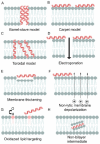An Update on the Therapeutic Potential of Antimicrobial Peptides against Acinetobacter baumannii Infections
- PMID: 37765087
- PMCID: PMC10537560
- DOI: 10.3390/ph16091281
An Update on the Therapeutic Potential of Antimicrobial Peptides against Acinetobacter baumannii Infections
Abstract
The rise in antibiotic-resistant strains of clinically important pathogens is a major threat to global health. The World Health Organization (WHO) has recognized the urgent need to develop alternative treatments to address the growing list of priority pathogens. Antimicrobial peptides (AMPs) rank among the suggested options with proven activity and high potential to be developed into effective drugs. Many AMPs are naturally produced by living organisms protecting the host against pathogens as a part of their innate immunity. Mechanisms associated with AMP actions include cell membrane disruption, cell wall weakening, protein synthesis inhibition, and interference in nucleic acid dynamics, inducing apoptosis and necrosis. Acinetobacter baumannii is a critical pathogen, as severe clinical implications have developed from isolates resistant to current antibiotic treatments and conventional control procedures, such as UV light, disinfectants, and drying. Here, we review the natural AMPs representing primary candidates for new anti-A. baumannii drugs in post-antibiotic-era and present computational tools to develop the next generation of AMPs with greater microbicidal activity and reduced toxicity.
Keywords: AMP; Acinetobacter baumannii; mechanism of action; resistance.
Conflict of interest statement
The authors declare no conflict of interest.
Figures



Similar articles
-
Antimicrobial peptides as a promising treatment option against Acinetobacter baumannii infections.Microb Pathog. 2020 Sep;146:104238. doi: 10.1016/j.micpath.2020.104238. Epub 2020 May 5. Microb Pathog. 2020. PMID: 32387392 Review.
-
Development of Antimicrobial Therapy Methods to Overcome the Antibiotic Resistance of Acinetobacter baumannii.Acta Naturae. 2020 Jul-Sep;12(3):34-45. doi: 10.32607/actanaturae.10955. Acta Naturae. 2020. PMID: 33173595 Free PMC article.
-
The Antimicrobial Peptide Esc(1-21) Synergizes with Colistin in Inhibiting the Growth and in Killing Multidrug Resistant Acinetobacter baumannii Strains.Antibiotics (Basel). 2022 Feb 11;11(2):234. doi: 10.3390/antibiotics11020234. Antibiotics (Basel). 2022. PMID: 35203836 Free PMC article.
-
In vitro and in silico comparative evaluation of anti-Acinetobacter baumannii peptides.J Microbiol Biotechnol. 2015 Oct 2. doi: 10.4014/jmb.1508.08064. Online ahead of print. J Microbiol Biotechnol. 2015. PMID: 26428729
-
Acinetobacter baumannii: Pathogenesis, virulence factors, novel therapeutic options and mechanisms of resistance to antimicrobial agents with emphasis on tigecycline.J Clin Pharm Ther. 2022 Nov;47(11):1875-1884. doi: 10.1111/jcpt.13787. Epub 2022 Oct 6. J Clin Pharm Ther. 2022. PMID: 36200470 Review.
Cited by
-
Acinetobacter baumannii: an evolving and cunning opponent.Front Microbiol. 2024 Jan 22;15:1332108. doi: 10.3389/fmicb.2024.1332108. eCollection 2024. Front Microbiol. 2024. PMID: 38318341 Free PMC article. Review.
-
Cyclic Peptide MV6, an Aminoglycoside Efficacy Enhancer Against Acinetobacter baumannii.Antibiotics (Basel). 2024 Dec 1;13(12):1147. doi: 10.3390/antibiotics13121147. Antibiotics (Basel). 2024. PMID: 39766537 Free PMC article.
-
Acinetobacter baumannii Complex Infections: New Treatment Options in the Antibiotic Pipeline.Microorganisms. 2025 Feb 7;13(2):356. doi: 10.3390/microorganisms13020356. Microorganisms. 2025. PMID: 40005723 Free PMC article. Review.
-
Rapid Membrane-Penetrating Hybrid Peptides Achieve Efficient Dual Antimicrobial and Antibiofilm Activity through a Triple Bactericidal Mechanism.ACS Omega. 2024 Jun 5;9(24):26133-26148. doi: 10.1021/acsomega.4c01577. eCollection 2024 Jun 18. ACS Omega. 2024. PMID: 38911764 Free PMC article.
-
Effect of Camel Peptide on the Biofilm of Staphylococcus epidermidis and Staphylococcus haemolyticus Formed on Orthopedic Implants.Antibiotics (Basel). 2023 Nov 28;12(12):1671. doi: 10.3390/antibiotics12121671. Antibiotics (Basel). 2023. PMID: 38136705 Free PMC article.
References
-
- O’Neill J. Tackling Drug-Resistance Infections Globally: Final Report and Recommendations. The Review on Antimicrobial Resistance; Government of the United Kingdom; London, UK: 2016. 84p
-
- Tacconelli E., Carrara E., Savoldi A., Harbarth S., Mendelson M., Monnet D.L., Pulcini C., Kahlmeter G., Kluytmans J., Carmeli Y., et al. Discovery, research, and development of new. antibiotics: The WHO priority list of antibiotic-resistant bacteria and tuberculosis. Lancet Infect. Dis. 2018;18:318–327. doi: 10.1016/S1473-3099(17)30753-3. - DOI - PubMed
-
- Fernández L., Breidenstein E.B.M., Hancock R.E.W. Importance of adaptive and stepwise changes in the rise and spread of antimicrobial resistance. In: Keen P., Monforts M., editors. Antimicrobial Resistance in the Environment. Wiley-Blackwell; Hoboken, NJ, USA: 2011. pp. 43–71.
Publication types
Grants and funding
LinkOut - more resources
Full Text Sources
Molecular Biology Databases

